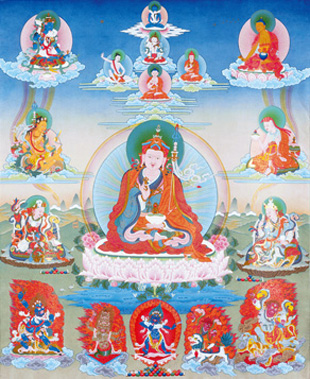Eight Manifestations of Guru Rinpoche: Difference between revisions
mNo edit summary |
mNo edit summary |
||
| Line 1: | Line 1: | ||
[[Image:8_Manifestations.jpg|frame|Part of the personal collection of Sogyal Rinpoche. Painted by Salga. ©Tertön Sogyal Trust]] | [[Image:8_Manifestations.jpg|frame|Part of the personal collection of Sogyal Rinpoche. Painted by Salga. ©Tertön Sogyal Trust]] | ||
'''Eight Manifestations of Guru Rinpoche''' (Tib. གུ་རུ་མཚན་བརྒྱད་, ''guru tsen gyé''; [[Wyl.]] ''gu ru mtshan brgyad'') are the eight principal forms assumed by [[Guru Rinpoche]] at different points in his life: | The '''Eight Manifestations of Guru Rinpoche''' (Tib. གུ་རུ་མཚན་བརྒྱད་, ''guru tsen gyé''; [[Wyl.]] ''gu ru mtshan brgyad'') are the eight principal forms assumed by [[Guru Rinpoche]] at different points in his life: | ||
#[[Guru Tsokyé Dorje]] (birth) | #[[Guru Tsokyé Dorje]] (birth) | ||
Revision as of 08:03, 21 August 2011

The Eight Manifestations of Guru Rinpoche (Tib. གུ་རུ་མཚན་བརྒྱད་, guru tsen gyé; Wyl. gu ru mtshan brgyad) are the eight principal forms assumed by Guru Rinpoche at different points in his life:
- Guru Tsokyé Dorje (birth)
- Guru Shakya Sengé (ordination)
- Guru Nyima Özer (subjugating demonic spirits)
- Guru Padmasambhava (establishing Buddhism in Tibet)
- Guru Loden Choksé (mastery of the teachings)
- Guru Pema Gyalpo (kingship)
- Guru Sengé Dradrok (subjugation of non-buddhists)
- Guru Dorje Drolö (concealing terma, binding spirits under oath)
The Eight Manifestations of Padmasambhava do not depict different Padmasambhavas, but reflect his ability to appear according to different needs and demands. In fact, they are called in Tibetan Guru Tsen Gyé, the eight ‘names’ of the Guru; each manifestation demonstrates a different principle that unveils the innermost nature of mind. As Guru Rinpoche said: “Mind itself is Padmasambhava; there is no practice or meditation apart from that.”[1]
Alternative Names & Lists Include:
- Orgyen Dorje Chang (Skt. Guru Vajradhara)
- Pemajungné (Skt. Padmakara) (central image?)
In the empowerment of Tukdrup Yang Nying Kundü, Guru Rinpoche and his Eight Manifestations appear as:
- the master Padma Thötreng,
- the vidyadhara Padmajungné,
- the bhikshu Padmasambhava,
- the scholar Loden Choksé,
- the majestic and overpowering Padma Gyalpo,
- the yogin Nyima Özer,
- the bhagavan Shakya Sengé,
- the great wrathful Senge Dradok and
- the crazy Dorje Drolö.[2]
Gallery
Sets of thangkas of the Eight Manifestations include a central image of Guru Pema Jungné.
-
Pema Jungné or Tsokyé Dorje?
-
Orgyen Dorje Chang
-
Shakya Sengé
-
Nyima Özer
-
Padmasambhava
-
Loden Choksé
-
Pema Gyalpo
-
Sengé Dradok
-
Dorje Drolö
The Empowerment of Padmasambhava and his Eight Manifestations
- Tukdrup Yang Nying Kundü (Tib.), the empowerment of Padmasambhava and his Eight Manifestations according to the Sangwa Gyachen (Tib.), the Pure Visions of the Great Fifth Dalai Lama, has been given to the Rigpa sangha by His Holiness the Dalai Lama at:
- the Pagode de Vincennes in Paris, 1982,
- San Jose 1989 and
- Lerab Gar 2000.
References
- ↑ Adapted from Dzogchen & Padmasambhava
- ↑ Dalai Lama, Dzogchen, page 230.
Further Reading
- Chögyam Trungpa, Crazy Wisdom, The Collected Works of Chögyam Trungpa, Volume Five (Boston & London: Shambhala, 2004).
- Yeshe Tsogyal, Life and Liberation of Padmasambhava, translated by Kenneth Douglas and Gwendolyn Bays (Emeryville: Dharma Publishing, 1978, republished 2008).
- Yeshe Tsogyal, Padmasambhava Comes to Tibet: 25 Disciples - Vajra Guru Mantra - Prayers, Dharma Publishing, 2008.
- The Venerable Khenchen Palden Sherab Rinpoche, The Eight Manifestations of GURU PADMASAMBHAVA, translated by the Venerable Khenpo Tsewang Dongyal Rinpoche








